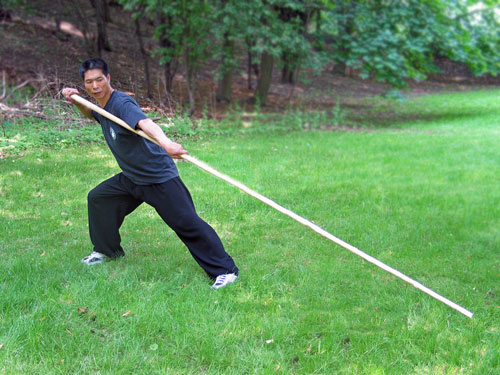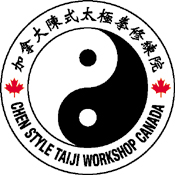|
Chen Family Taijiquan 13 Posture
Long Pole

The curriculum of Chen style Taiji includes the practice of a
13 movement long pole (Da Gun) form. Practice of the form trains
the fundamentals of Taijiquan including the Eight Methods - Peng
(Ward Off), Lu (Roll Back), Ji (Press), An (Press Down), Cai (Plucking),
Lieh (Splitting), Zhou (Elbow), Kao (Lean) - plus "grasp
& block" (Qin Na) and spiral movement (Silk Reeling).
Of the Eight Methods, the practice is especially helpful and beneficial
to the training of Lu, Cai, horizontal Lieh and the ability to
release energy (Fa Jing). Practice of the long pole can increase
the strength and power of the muscles of one's shoulders, back,
waist, and legs. Through the practice, students improve their
ability to release energy and increase their understanding of
the Eight Methods.
In empty-hand practice, one learns to direct energy to the hands
(Fa Jing). In long pole training, one learns to collect internal
energy (Nei Qi) and internal strength (Nei Jing) and direct them
to the tip of the pole. In practicing the long pole, the body
and the pole combine to become a single unit, the pole becoming
an extension of one's arms. This training aids one in understand
how to release energy (Fa Jing), a critical element of self defense
in Taijiquan. When the long pole is practiced with a partner,
"sticky pole" exercises train many of the same skills
used in push hands practice. Consequently, partner practice with
a long pole can enhance push hands skills and self defense techniques.
Practice of the long pole form can be beneficial for students
of all ages and physical abilities. Students can practice the
form with a longer or shorter pole, choosing a length that is
suited to the physical build and abilities of the individual student.
Practice of the long pole provides students with an additional
form of physical exercise, one that will improve their practice
of Taijiquan forms and, for students who practices diligently,
also enhance their self defense skills.
|

